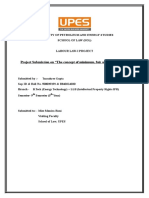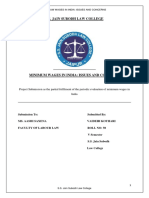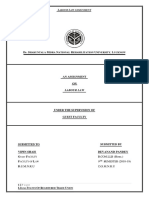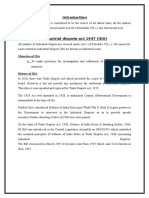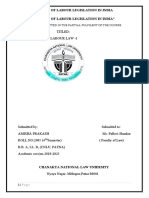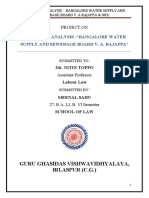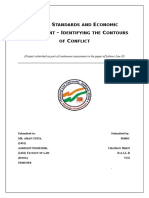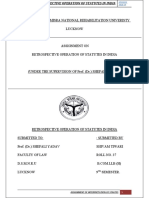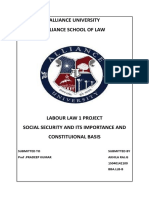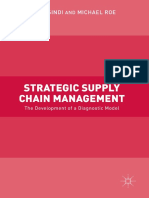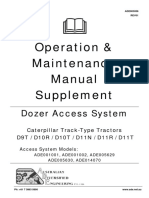National Law University Odisha: Semester Viii (4 Year) Labour Law-2 Project "U W ' W: I I "
National Law University Odisha: Semester Viii (4 Year) Labour Law-2 Project "U W ' W: I I "
Uploaded by
Shreya KumariCopyright:
Available Formats
National Law University Odisha: Semester Viii (4 Year) Labour Law-2 Project "U W ' W: I I "
National Law University Odisha: Semester Viii (4 Year) Labour Law-2 Project "U W ' W: I I "
Uploaded by
Shreya KumariOriginal Description:
Original Title
Copyright
Available Formats
Share this document
Did you find this document useful?
Is this content inappropriate?
Copyright:
Available Formats
National Law University Odisha: Semester Viii (4 Year) Labour Law-2 Project "U W ' W: I I "
National Law University Odisha: Semester Viii (4 Year) Labour Law-2 Project "U W ' W: I I "
Uploaded by
Shreya KumariCopyright:
Available Formats
NATIONAL LAW UNIVERSITY ODISHA
SEMESTER VIII (4TH YEAR)
LABOUR LAW- 2 PROJECT
“UNORGANISED WORKERS' WELFARE: IMPERATIVES AND INITIATIVES”
UNDER THE GUIDANCE OF & SUBMITTED TO:
A. ARUNA SRI LAXMI
SOHINI MAHAPATRA
SUBMITTED BY:
KAVYA LALCHANDANI (2016/BBA LLB/026)
MEDHASHREE VERMA (2016/BA LLB/032))
UNORGANISED WORKERS' WELFARE: IMPERATIVES AND INITIATIVES
TABLE OF CONTENTS
SUMMARY OF THE ARTICLE 2
RESPONSE IN FAVOUR OF THE AUTHORS 3
RESPONSE IN DISSENT WITH THE AUHTOR 7
LABOUR LAW-2 PAGE | 1
UNORGANISED WORKERS' WELFARE: IMPERATIVES AND INITIATIVES
SUMMARY OF THE ARTICLE
The article titled ‘Unorganized Workers' Welfare: Imperatives & Initiatives’ has been co-
authorsed by M.S. Ramanujam and K.L. Rawal. They address issues regarding the welfare
and development of the unorganised sector in the country. They state that most of the
unorganised workers are marginalised, do not have any access to education, are illiterate, do
not have access to social security measures and are vulnerable to different plots by the
employer and other people. Moreover, they assert that these workers are not even aware of
the various laws and schemes that are put in place for them. They point out to various field
investigations to state that the productivity of these workers has been on a continuous decline
and that there is no way in which a proper statistics has been maintained of these workers.
They further state that the middlemen have worked to the disadvantage of these workers who
meddle with the benefits which are meant solely for the benefit of the workers. Further, they
provide for a classification of these workers and list down the differences between the
organised and the unorganised sector and the disadvantages that these workers have to suffer
from due to such classification. He discusses the different welfare models that the
government has been using for the unorganised sector namely, Welfare Fund Model, The
Social Assistance Model, The Social Security Scheme Model and the Mutual Help Model.
They further discuss how the welfare model and the funds system are inadequate in providing
the cover that must be granted to these workers. They highlight the issues of identification of
beneficiaries, administration of welfare funds, usage of authorsised agencies and self help
groups in the process, registration and survey of workers, income ceiling, registration of
workers and understanding the scope of welfare legislations. They conclude by stating that
the non-beneficiaries must not find a way to availing benefits of the act that is only made for
the unorganised sector. Special attention must be paid to women and old age healthcare
issues.
It is also pointed out as to how centre and state are having uneven measures to combat this
problem.
LABOUR LAW-2 PAGE | 2
UNORGANISED WORKERS' WELFARE: IMPERATIVES AND INITIATIVES
RESPONSE IN FAVOUR OF THE AUTHORS
Unorganised working class is often more vulnerable than the organised workforce as the
benefits of any legislation or scheme rolled out by government hardly reaches to them and
authors correctly differentiates between the two to indicate how the unorganised workforce is
not treated at par with the organised workforce. Some of the pressing problems in this sector
are that of low wages, not up to the mark working conditions, no pay on overtime, little or no
right to demand leaves, and mostly they do not have the knowledge of any of the benefits
conferred under any scheme and Act applicable to them. Since India is a developing country,
it is pushing itself hard to provide for the social and economic protection where as there are
other States who can afford to provide for their social and economic promotion to such
workers.
Workers are usually employed in the unorganised sector due to illiteracy and lack of any skill
and their position which can be contingently or generally vulnerable forces them to seek such
kind of employment. This leads to them being caught in a vicious circle of exploitation by the
employers as there is no formal drawing up of contracts or arrangements leading to no job
security. This leads to them having little or no recourse to any authority. They are the last
priority for any government as can be seen by the latest reforms for Covid-19. Not only such
workers were left stateless, but also were deprived of basic necessities. Only construction
workers were given some respite but the benefit on a practical level did not reach the workers
and they still continue to suffer.
The authors rely on authentic data provided by National Commission on Enterprises in the
Unorganised Sector (NCEUS) and concludes that this sector accounts for almost 93% of
employment generated in India and contribution to the GDP is 50% highlighting the
importance of the same. Even then only 6% of such workers are covered under any scheme or
benefit. There is a need for both reactive and proactive social assistance in these sectors as
the benefit even if declared does not reach to such workers.
Since, in India we follow federal form of government, the Acts and schemes declared by the
Central government have to be implemented or adopted in different States and States can
have their separate legislations as well. It is seen that the initiatives by different state
LABOUR LAW-2 PAGE | 3
UNORGANISED WORKERS' WELFARE: IMPERATIVES AND INITIATIVES
government are not at par with each other or what has been declared by the Centre. Even if
the schemes are formed by the respective legislatures the implementation with the existing
machinery is a big hurdle. So the authors do not deny that there are schemes in existence and
even after 2010 ( the year this article was published) there have been new and revised
schemes in place but the problems still remain in their enforcement.
The only State that perhaps fares well is Kerala for its proactive role. Apart from the
examples of Kerala and ‘Mathadi workers’ given by the authors, Kerala had also in 2007
rolled out Kerala Fishermen’s and Allied Workers’ Welfare Cess Act, 2007 in which
mandates welfare contribution as a percentage of sale proceeds by those involved in fish
trading and exporting. Most importantly, the direct employer employee relationship is not
established in cases of unorganised labour therefore, a percentage of sale proceeds was a
correct way to make sure that the benefits reach the workers. Similarly, those engaged in
waste collection, working in forests, home-based workers who can’t establish a direct
employer worker relationship should not be deprived of the benefits. However, other States
have failed to do the same.
The Unorganised Workers Social Security Act was enacted in 2008 and Section 3
empowered the central government to roll out social security schemes which have been laid
down in Schedule 1 of the Act with some additional schemes concentrating on insurance 1 and
the Labour Law Legislations applicable to the unorganised workers are given under Schedule
2. Unfortunately even laying down extensive and full coverage schemes is not enough due to
the following reasons: first, there are a lot of obstacles in identifying the true and correct
beneficiaries of the Scheme; second, that the benefit announced at the Centre have not been
able to seep in into the federal structure and presence of middlemen who actively deprive
such workers from claiming the benefit. Deprivation of such benefits not only prisons the
right of such worker but also lowers the productivity of the unorganised sector.
Non-Identification or wrong identification is a big challenge as the unorganised working class
forms a huge percentage of employment and due to employer’s lack of motivation and deceit;
they do not even declare people as unorganised workers which automatically does not lead to
creation of identity cards or leads to creation of false identity cards thus depriving them of the
benefits. This is largely done by the employers to evade their responsibility of coming under
1Social Security Coverage Scheme for Workers in Unorganised Sector, (November 17, 2016 Business
Standard) <https://www.business-standard.com/article/government-press-release/social-security-coverage-
scheme-for-workers-in-unorganised-sector-116111601429_1.html> accessed on 10th April, 2020.
LABOUR LAW-2 PAGE | 4
UNORGANISED WORKERS' WELFARE: IMPERATIVES AND INITIATIVES
any Labour Legislations as then they will have to comply with provisions of Provident Fund,
Factories’ Act, etc.
Sensitising and making them aware of the importance of identity cards, reviewing of identity
cards after issuance and benefits conferred therein is an important step which the locally
elected representatives should carry out. This will generally avoid the problem of bogus
workers claiming to be an unorganised worker and also when does worker stop being an
unorganised worker. Local representative have to carry out these functions because the camps
when held will try to cover maximum number of people possible and therefore will end up
covering only a small number of population because of ever increasing population of India.
Federal Structure although complex to have practical solutions should be utilised by
appointing more district level bodies as they have a better practical experience with the
situation at ground. These bodies should not interfere in the distribution of benefits but only
to advise the State or the Centre about pressing problems of such workers because they
engage in geography specific work too. Like the minimum wage can vary for all States, the
umbrella legislations may have to be made suitable for working of the schemes at a State
level. In this federal structure NGOs can play a proactive role both for contribution of money
and imparting education to the unorganised workforce both for their rights and benefits.
The funding of the welfare funds established at the Central level and State level, have two
main sources: cess on various activities and employers’ contribution. The fact that authors
highlight that there should also be representation of the employee in contribution of funds is
sound on 2 grounds: the participation of the employee will increase and he will feel more
connected to the funds and its distribution and the Employer will also feel more motivated for
making his contribution to the funds. The Welfare funds cannot always indicate social
security, but often the economic and social benefits are interconnected and creation and
implementation of one creates room for another.
There are several reasons as to why Self-Help Groups could benefit the unorganised sector.
There are various advantages attached to such Groups. A single person is not left remediless
and rather can raise their voice against the oppression and exploitation of one; any benefit
which may be known to one is shared among hundreds; they can also create a common pool
of funds of whatever small their savings would be to help those in dire need. Like organised
workers have trade unions in order to work with the employees and the management, these
LABOUR LAW-2 PAGE | 5
UNORGANISED WORKERS' WELFARE: IMPERATIVES AND INITIATIVES
groups would be beneficial for the overall welfare of the organisation as well. They would
also be able to collectively come out of the overall administrative loopholes and latches.
Like in all other Labour Legislations, the unutilised benefit or compensation is due to the
heirs of the deceased, similar provisions do not exist for the benefits to the unorganised
workers. This is unfair because all the legislations are welfare legislations and all the schemes
made therein should also confer maximum benefit to the worker and his family. Otherwise,
the family will have nowhere to go after the death of the bread earner of the family. Even if
the benefit is less, the self-help group’s pool of money as suggested can be used to help the
family to an extent.
For carrying out various schemes and responsibilities of the Government, it is equally
important that there is adequate infrastructure for the same. Infrastructure does not mean
hiring more middle men because that will create more problems, but transparent machinery,
Smart Cards issued to those eligible, timely dispersal of the benefits.
The authors also correctly point out that there is a special requirement to take care of the
economic and social benefits to the women employees. Women employees are at a different
footing than men and hence there are benefits such as crèches, maternity benefits, daycares,
and flexible hours of work, which are more preferable for a woman working in an
unorganised sector than any raise in the economic benefit. Conditions of work should,
however be taken care of and improved for both men and women with fixed hours of work
and leeway for monthly and weekly leaves. Welfare Funds and Social Security funds cannot
take care of this therefore; adequate measures should be in place.
For furthering the argument, the authors could have, however used that how complex is the
established framework of authorities under the Act and various Rules under umbrella
legislations. It may have been legislatively sound for bodies to carry out their functions;
however, such workers working on meagre salary would not be able to understand the
hierarchy. They would just want quick remedy to their demand.
LABOUR LAW-2 PAGE | 6
UNORGANISED WORKERS' WELFARE: IMPERATIVES AND INITIATIVES
RESPONSE IN DISSENT WITH THE AUHTOR
The authors begin by stating that the unorganised workers do not have the awareness about
the welfare schemes and that the government machinery is such that it these workers miss the
attention of the government. However, numerous legislations and welfare measures have
been put in place by the government to meet the needs of the unorganised sector like the
Unorganised Workers' Social Security Act 2008, Pradhan Mantri Rojgar Protsahan Yojana,
Pradhan Mantri Jeevan Jyoti Bima Yojana, Pradhan Mantri Suraksha Bima Yojana, Pradhan
Mantri Shram Yogi Maandhan and the Ayushman Bharat Scheme.
While it is true that the unscrupulous middlemen cause trouble to such innocent workers,
such middlemen are not just a menace for the unorganised sector but the organised sector too.
The authors further state that the increased casualisation in jobs workers, the number in the
unorganised sector has increased and they continue to be marginalised. However, it has been
suggested that there has been a decrease in the number of such workers in the unorganised
sector. The labour and employment minister stated that there has been shrinkage in the
unorganised sector and that it is a ‘positive indicator’.2
The authors further classify the landless farmers as a part of the unorganised sector and that
fewer schemes are put in place for such farmers. However, the government at the centre has
been working on schemes specifically for them. While in the state of Odisha, Krushak
Assistance for Livelihood and Income Augmentation scheme took into account some 3 lakh
landless farmers to provide support and assistance to them.3
When it comes to another category of unorganised workers i.e. the domestic workers the
Domestic Workers Sector Skills Council has been established under the Ministry of Skill
2 Government to prepare national data on unorganised sector Read more at:
https://economictimesindiatimescom/news/economy/policy/government-to-prepare-national-data-on-
unorganisedsector/articleshow/70261192cms?
utm_source=contentofinterest&utm_medium=text&utm_campaign=cppst' (The economic times, Jul 17,
2019,) <https://economictimes.indiatimes.com/news/economy/policy/government-to-prepare-national-data-on-
unorganised-sector/articleshow/70261192.cms> accessed 19 April 2020
3 Central scheme for farmers left out the landless ones ' (Business Standard, February 15,
2019) <https://economictimes.indiatimes.com/news/economyhttps://www.business-standard.com/article/pti-
stories/central-scheme-for-farmers-left-out-the-landless-ones-119021501211_1.html/policy/government-to-
prepare-national-data-on-unorganised-sector/articleshow/70261192.cms> accessed 19 April 2020
LABOUR LAW-2 PAGE | 7
UNORGANISED WORKERS' WELFARE: IMPERATIVES AND INITIATIVES
development to look into the skill requirements of domestic workers and to make them
skilled and self sufficient. Therefore, the authors’ assertion that all such workers are left
unskilled and that the government is not able to pay attention them in not correctly placed. As
per the NSSO data around thirty nine lakh people in the country are employed as domestic
workers and the government is trying to come up with a National Policy with sole on
concentration on the welfare of such domestic workers. The policy which was proposed even
aimed at giving the domestic workers the right to for their own associations and unions and
the ability to register as unorganised workers, right to minimum wages and to receive
protection from domestic abuse.4
The authors further state that the welfare measures have been restricted to only the organised
sector and that the same is not available to the unorganised sector. However, a lot of schemes
have been put in place by the government that would suggest otherwise. These include
National Old Age Pension Scheme, National Family Benefit Scheme, Janani Suraksha
Yojana. The authors raise policy issues such as social assistance and securing the livelihood
and lives of the unorganised workers. However, the current policies and Acts have got these
concerns covered within it. The Pradhan Mantri Jeevan Jyoti Bima Yojana provides that
gives a cover of Rupees 2 lakhs to the people working for the unorganised sector from the
age of 18-50 on death at the rate of 330 rupees per annum.
Moreover, the Pradhan Mantri Suraksha Bima Yojana provides the unorganised sector with a
cover in case of accidents and disabilities at the rate of rupees 12 per annum and it also
provides a cover of rupees 2 Lakhs. The annual premiums for these schemes are shared
between the state and the central government in equal proportion to meet the needs of the
beneficiaries and the people working in the unorganised sector. The authors call for direct
state interventions and the same has been done by the government as these schemes of
insurance are directly performed by the government under its own national insurance
platform which is the Life Insurance Corporation of India.
The authors state that the welfare schemes must not just be reactive but also proactive. It is
opined that coming up with welfare legislations such as the Pradhan Mantri Suraksha Bima
Yojana and the Pradhan Mantri Jeevan Jyoti Bima Yojana are proactive actions that are being
taken by the government now.
4 https://pib.gov.in/Pressreleaseshare.aspx?PRID=1558848
LABOUR LAW-2 PAGE | 8
UNORGANISED WORKERS' WELFARE: IMPERATIVES AND INITIATIVES
The authors discuss at length about the welfare funds that are put in place. However, after the
enactment of numerous welfare legislations that did not exist back in 2010, the vitality that
can be attached to these welfare funds when it came to being a pillar of security for
unorganised sector has reduced. The authors further state that the welfare schemes and the
welfare funds that are put in place for the Building and construction workers are not
sufficient and that they do not provide old age and health security. However after the
Supreme Court order5 of 2018, the ministry of labour came up with a specific welfare scheme
for the building and other construction workers. Separate categories were made for the
workers who were covered under the Ayush scheme and those who were not. For those
construction workers that were not covered by the said scheme, paid maternity leave was
given to them ranging from 90 days to 26 weeks. For the registered construction workers,
Rupees six thousand is given per delivery for two deliveries. Moreover the other insurance,
health, social security, old age protection concerns are met by the Unorganised Workers’
Social Security Act of 2008.6 The authors further state that the issue of identification of
beneficiaries has been a consistent problem. However, as per the data available the
beneficiaries of the Pradhan Mantri Rojgar Protsahan Yojana scheme crossed the record
number of 1.2 Crores in a time span of three years which shows that the number of
registrations for such beneficial schemes has indeed increased. The authors further state that
smart cards must be introduced and distributed amongst the workers which is a welcome
thought. However, the reasoning behind the same does not appear well placed. More than the
harm that middlemen do to the process of execution of beneficial legislation is lack of proper
methods of data collection. It is the number of regular surveys that must increase at the
ground level for the government to be aware of the exact number of workers that require help
and protection.
The authors further points out that there is gap in understanding the scope and the
effectiveness of the schemes and acts put in place by the government. However, no plausible
solution is offered by the authors regarding the same. The scope of the acts and schemes must
be made absolutely clear with the intended beneficiaries within the Acts and the schemes
itself. The enforcement authorsities must be given proper training and introduction to the new
schemes that are put in place by the government and the best ways to execute such schemes
5 National Campaign Committee for Central Legislation on Construction Labour v/s Union of India & Others,
W.P. (C) No. 318/2006.
6 https://pib.gov.in/newsite/PrintRelease.aspx?relid=186481
LABOUR LAW-2 PAGE | 9
UNORGANISED WORKERS' WELFARE: IMPERATIVES AND INITIATIVES
and acts so that their duties are discharged with utmost efficacy and efficiency. Such steps
would clear the confusions that may be caused by the lack of clarity caused by the lack of
proper criteria on basis of which the intended beneficiaries are taken into account, their
eligibility that has been decided for claiming the benefits that are targeted, and to understand
the procedure for claiming and re-claiming the benefits intended under the particular Act and
welfare schemes. The authors in the end discuss issues pertaining to old age, women specific
issues and the problems caused to the families due to deaths and accidents. It is opined that
these issued have already been comprehensively covered by the Unorganised Workers' Social
Security Act of 2008. Moreover, the authors stresses on the suggestions of pushing forward
for skill enhancement programmes, causing agricultural regeneration, and increasing the
micro to small scale enterprises for the agricultural and the farmers sector. It is submitted that
the schemes targeting these suggestion have been put in place by the central government and
various state governments as well. The authors blames the system of having middle men at all
important contact points for these workers and at all the pints at which the benefits are
granted as a major hurdle because of which the benefit does not reach the workers in the
organised sector at all. However, these issues are now getting resolved as most of the
monetary benefit is directly transferred to the bank accounts of the beneficiaries and so the
role of such middle men has reduced and the workers get full amount to which they are
entitled. Moving the system of distribution of benefits it’s thus very important to ensure that
corruption is removed from all the levels of the implementation structure. This issue has not
been put forth by the authors, however, online modes were not common in the past decade
but they provide an excellent solution in today’s times. The authors conclude that
identification of beneficiaries is important and co-operation is required at all the stages of the
government machinery to provide the required care and support to the unorganised sector.
LABOUR LAW-2 PAGE | 10
You might also like
- Critical Scrutiny of No Work No Pay' Doctrine in Labour LawDocument14 pagesCritical Scrutiny of No Work No Pay' Doctrine in Labour LawdivyavishalNo ratings yet
- Labour Law ProjectDocument13 pagesLabour Law ProjectTanushree GuptaNo ratings yet
- Nikita Ganesh - Labour Law Project SEM VIIIDocument21 pagesNikita Ganesh - Labour Law Project SEM VIIINikitaNo ratings yet
- Labour LawDocument32 pagesLabour Lawrupak kumarNo ratings yet
- Labour Law II ProjectDocument13 pagesLabour Law II ProjectSwapna SinghNo ratings yet
- Alliance School of LawDocument20 pagesAlliance School of LawAarav TripathiNo ratings yet
- Unorganised Labour - Labour Law IIDocument23 pagesUnorganised Labour - Labour Law IIAman BeriwalNo ratings yet
- Labour Law - 1 Prashant Verma 2016ballb 98Document19 pagesLabour Law - 1 Prashant Verma 2016ballb 98Digpal MoryaNo ratings yet
- Labour Law ProjectDocument20 pagesLabour Law Projectaltmash100% (1)
- Labour Law ProjectDocument23 pagesLabour Law ProjectMohammad Shaique50% (2)
- Labour Law ProjectDocument18 pagesLabour Law Projectdiwakar chiraniaNo ratings yet
- Labour Law ProjectDocument18 pagesLabour Law ProjectCHANDRIKANo ratings yet
- Labour Law - II - Case Analysis - Submission - Rahul - 17B116Document4 pagesLabour Law - II - Case Analysis - Submission - Rahul - 17B116Rahul KanoujiaNo ratings yet
- Labour Law ProjectDocument20 pagesLabour Law ProjectRajat KaushikNo ratings yet
- Labour LawDocument23 pagesLabour Lawanumodi100% (2)
- Labour LawDocument19 pagesLabour LawVaidehi KothariNo ratings yet
- Labour Law ProjectDocument14 pagesLabour Law ProjectSadhvi SinghNo ratings yet
- Dr. Ram Mahohar Lohiya National Law UniversityDocument15 pagesDr. Ram Mahohar Lohiya National Law UniversityShailesh KumarNo ratings yet
- Labour Law AssignmentDocument11 pagesLabour Law AssignmentDevanand PandeyNo ratings yet
- Labour Law ProjectDocument21 pagesLabour Law Projectchetanbhavesh100% (1)
- Labour Law II ProjectDocument20 pagesLabour Law II ProjectShubham Phophalia100% (1)
- Chanakya National Law University: (Faculty For Labour Law I)Document23 pagesChanakya National Law University: (Faculty For Labour Law I)anonymous67% (3)
- Labour Law ProjectDocument17 pagesLabour Law ProjectKunal Singh100% (1)
- Labour Law 1Document30 pagesLabour Law 1Noel PannaNo ratings yet
- Labour Law ProjectDocument15 pagesLabour Law ProjectShubh Dixit100% (1)
- Property Project - FinalDocument19 pagesProperty Project - FinalAmiya UpadhyayNo ratings yet
- Dr. Ram Manohar Lohiya National Law University, Lucknow 2020-2021Document12 pagesDr. Ram Manohar Lohiya National Law University, Lucknow 2020-2021shivamNo ratings yet
- Labour Law Project.Document21 pagesLabour Law Project.Vaibhav KalraNo ratings yet
- Labour Law Bba 1Document16 pagesLabour Law Bba 1Minhaj KhurshidNo ratings yet
- Central University OF South, Bihar: SUBJECT:-Interpretation of Statutes Submitted ToDocument12 pagesCentral University OF South, Bihar: SUBJECT:-Interpretation of Statutes Submitted Toyashasavi singhNo ratings yet
- Labour Law Project MainDocument23 pagesLabour Law Project MainRamanDhimanNo ratings yet
- Labour Law 2 OriginalDocument28 pagesLabour Law 2 OriginalHarshit MalviyaNo ratings yet
- A Critical Analysis - "Bangalore Water Supply and Sewerage Board V. A. Rajappa"Document21 pagesA Critical Analysis - "Bangalore Water Supply and Sewerage Board V. A. Rajappa"animesh100% (2)
- Labour Law ProjectDocument12 pagesLabour Law Projectbobby choudharyNo ratings yet
- Labour Law 2 Rough DrraftDocument5 pagesLabour Law 2 Rough DrraftakhilgrajNo ratings yet
- Labour Law ProjectDocument19 pagesLabour Law ProjectdivyavishalNo ratings yet
- Labour Law II Project - 17ba070 (Bba052)Document13 pagesLabour Law II Project - 17ba070 (Bba052)Swapna SinghNo ratings yet
- Labour Law CaseDocument15 pagesLabour Law CaseHrishika Netam100% (1)
- Labour Law ProjectDocument30 pagesLabour Law ProjectadvikaNo ratings yet
- Labour Law ProjectDocument11 pagesLabour Law ProjectdivyavishalNo ratings yet
- Tax 2 ProjectDocument15 pagesTax 2 ProjectamanasheshNo ratings yet
- Principles of Taxation Sem 5Document27 pagesPrinciples of Taxation Sem 5moulik shrivastavaNo ratings yet
- Administrative Law Final DraftDocument17 pagesAdministrative Law Final DraftShivam KumarNo ratings yet
- Trade Law ProjectDocument19 pagesTrade Law ProjectNavonil DattaNo ratings yet
- Interpretation of Statute ProjectDocument13 pagesInterpretation of Statute Projectshivam tiwariNo ratings yet
- Tax Law I Project, 2019Document18 pagesTax Law I Project, 2019Ayush AgrawalNo ratings yet
- Research MethodologyDocument18 pagesResearch MethodologyAsha Yadav0% (1)
- International Labour Standards and Its Implementation in IndiaDocument9 pagesInternational Labour Standards and Its Implementation in IndiaDebasish NandaNo ratings yet
- Labor Law 2 ProjectDocument13 pagesLabor Law 2 ProjectHemantPrajapatiNo ratings yet
- Central University of South Bihar: Topic-Directors:Meaninglegal Position, Appointment& Re-AppointmentDocument23 pagesCentral University of South Bihar: Topic-Directors:Meaninglegal Position, Appointment& Re-AppointmentpushpanjaliNo ratings yet
- Constitutional Validity of Minimum Wages ActDocument4 pagesConstitutional Validity of Minimum Wages ActAkshat JaiswalNo ratings yet
- Labour Law ProjectDocument31 pagesLabour Law Projectasha sreedharNo ratings yet
- International LawDocument13 pagesInternational LawAarsee Jain100% (1)
- Labour LawDocument20 pagesLabour LawPratiyush KumarNo ratings yet
- Labour 2016BALLB132BDocument18 pagesLabour 2016BALLB132BNikhil AradheNo ratings yet
- Dr. Ram Manohar Lohiya National Law University, Lucknow: Labour Outsourcing in IndiaDocument12 pagesDr. Ram Manohar Lohiya National Law University, Lucknow: Labour Outsourcing in Indiahardik anandNo ratings yet
- Alliance University Alliance School of LawDocument26 pagesAlliance University Alliance School of LawakhilaNo ratings yet
- Labour Law IIProjectDocument20 pagesLabour Law IIProjectPalash PuriNo ratings yet
- Corporate Social Responsibility and Labour WelfareDocument18 pagesCorporate Social Responsibility and Labour Welfaremanu mishraNo ratings yet
- Lte HandoverDocument17 pagesLte HandoveraghyadNo ratings yet
- Water WaterDocument2 pagesWater WaterHannah CorpuzNo ratings yet
- Introduction To Scratch ProgrammingDocument7 pagesIntroduction To Scratch Programmingodhiambojoseph281No ratings yet
- Atlas Programming Guide PreliDocument181 pagesAtlas Programming Guide Prelid1140998No ratings yet
- Astro Hog Flying Instructions by Fred DunnDocument2 pagesAstro Hog Flying Instructions by Fred DunnRicardo SalazarNo ratings yet
- Strategic Supply Chain Management The Development of A Diagnostic ModelDocument277 pagesStrategic Supply Chain Management The Development of A Diagnostic ModelKumar SaurabhNo ratings yet
- Coliform Bacteria and Drinking Water: Questions & AnswersDocument2 pagesColiform Bacteria and Drinking Water: Questions & AnswersLiaPrem0% (1)
- The Role of Reserve Bank of India in The Economy and Social DevelopmentDocument25 pagesThe Role of Reserve Bank of India in The Economy and Social DevelopmentFranxx DarlingNo ratings yet
- For Data Safety: Written Information Security PlanDocument1 pageFor Data Safety: Written Information Security Planhiamang27No ratings yet
- Open Mapping Theorem (Complex Analysis) PDFDocument2 pagesOpen Mapping Theorem (Complex Analysis) PDFCory BlackwellNo ratings yet
- SRODocument17 pagesSROPayas TalwarNo ratings yet
- Scientists Prove Abiotic Oil Is Real!Document4 pagesScientists Prove Abiotic Oil Is Real!Eddie WinklerNo ratings yet
- Vacant Lot RubricDocument2 pagesVacant Lot Rubricapi-548712254No ratings yet
- Uflex Packaging StartegyDocument91 pagesUflex Packaging StartegyRahul Jamdagni100% (1)
- Ayurvedic Formulations (Ashava, Aritha, Kwath, Etc.) : Profile No.: 02 NIC Code: 21003Document15 pagesAyurvedic Formulations (Ashava, Aritha, Kwath, Etc.) : Profile No.: 02 NIC Code: 21003Sabhaya Chirag100% (1)
- COB ReportsDocument13 pagesCOB ReportsEmmanuel Uchenna Chukwu100% (2)
- Javascript Events: W3SchoolsDocument3 pagesJavascript Events: W3SchoolsoussamaNo ratings yet
- MC 34119Document12 pagesMC 34119Susan PastranaNo ratings yet
- HW, Leadership Capacity BuildingDocument8 pagesHW, Leadership Capacity BuildingGuyo Dima AreroNo ratings yet
- Buencamino V CaDocument3 pagesBuencamino V CashelNo ratings yet
- Resume RomilShah Sept2017Document1 pageResume RomilShah Sept2017Romil ShahNo ratings yet
- BTL - 5000 SWT - Service Manual PDFDocument158 pagesBTL - 5000 SWT - Service Manual PDFNuno Freitas Bastos100% (1)
- 1 Module1Document56 pages1 Module1Nidhi CharateNo ratings yet
- Operation/Technical ManualDocument64 pagesOperation/Technical ManualBilal AloulouNo ratings yet
- Operation & Maintenance Manual Supplement: Dozer Access SystemDocument19 pagesOperation & Maintenance Manual Supplement: Dozer Access SystemGhassan Ilias AlkikiNo ratings yet
- Pac Registration Guide For Fiji and TongaDocument18 pagesPac Registration Guide For Fiji and TongaAnishilNo ratings yet
- BurningrateDocument60 pagesBurningrateasuNo ratings yet
- Cessna C172 SOP February 2017Document226 pagesCessna C172 SOP February 2017esubalew galloNo ratings yet
- 2012 USBSEC Brochure 2Document54 pages2012 USBSEC Brochure 2Jorge GómezNo ratings yet
- Promotion Strategy of IKIO Coffee As A Tourism Spot in Madiun CityDocument48 pagesPromotion Strategy of IKIO Coffee As A Tourism Spot in Madiun CityDean FaizNo ratings yet

